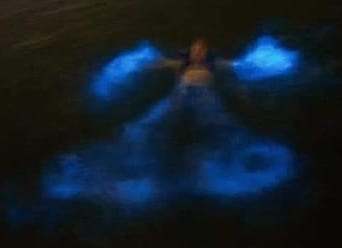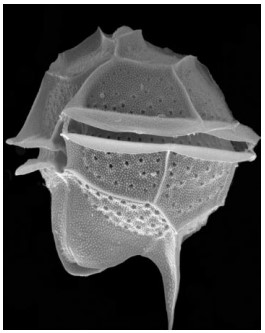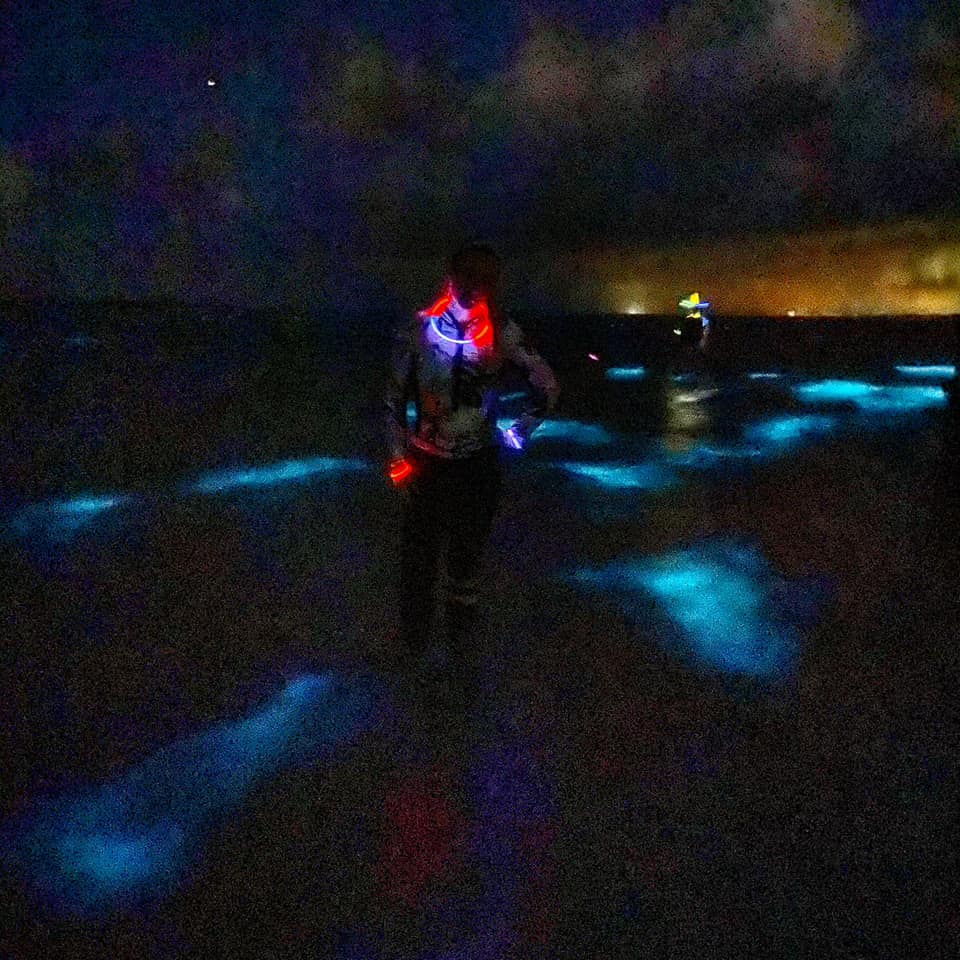
Puerto Rico is famous for its bioluminescent bays, but did you know that we have the same organism creating bioluminescence right here in Florida? Each summer, the northern Indian River Lagoon attracts visitors at night for a special sight – glowing water. Many people know that this glow is bioluminescence caused by microscopic algae – but what do we know beyond that? I took a deeper dive to understand the creature that causes our intense summer bioluminescence – and what it means for our ecosystem.
Bioluminescence is the creation of light by a living organism. Many creatures produce bioluminescence, including fireflies and some deep-sea fish. The light is produced through a chemical reaction using a compound they produce called luciferin and the enzyme luciferase. Bioluminescence may be used to confuse attackers, lure in prey, or find a mate.
Pyrodinium bahamense: the organism responsible for our glowing waters

The organism responsible for producing bioluminescence in the Indian River Lagoon is a dinoflagellate known by the scientific name Pyrodinium bahamense. Dinoflagellates are a type of phytoplankton. They are single-celled organisms that use chloroplasts to photosynthesize, and receive their name from flagella, or whip-like tail. This means they can swim around, although not very far!

Pyrodinium bahamense produces bioluminescence when touched. Scientists still aren’t 100% sure of the reason, but they think this serves as a type of alarm to warn off or escape predators. The phytoplankton can’t tell what is and is not a predator – so our boat engines, kayak paddles, and even hands running through the water can all be the cause of the chemical reaction that results in the glow!
Pyrodinium bahamense was given its name because it was first discovered in the Bahamas. You may have heard of it indirectly, as it is responsible for famous bioluminescent bays in the Bahamas and Puerto Rico. It prefers high salinity and warm waters, meaning that the summer waters of our Indian River Lagoon are an ideal habitat. Like other types of algae, it also requires the nutrient nitrogen. As Florida’s population continues to grow and the nutrient inputs from septic systems, fertilizers, and runoff increase, more nitrogen flows into the water. The result? The bioluminescence seems to be getting stronger every year.
The downside of bioluminescent blooms
Those of us who love to paddle and see the bioluminescence get excited when we have a strong bioluminescence season. And biologically speaking, some phytoplankton is important to the ecosystem – it creates food from sun energy and forms the base of the food web. However, too much algae can be a problem. When there are a lot of nutrients and sunlight, phytoplankton can grow and multiply rapidly, producing an algae bloom. Algae blooms decrease water clarity, making it harder for our important seagrasses to get the sunlight they need to photosynthesize. In addition, when those algae die, they are broken down by bacteria through a process called aerobic respiration. This process uses oxygen in the water, resulting in low oxygen conditions that can be harmful to fish and other wildlife.
Pyrodinium bahamense blooms have another potential impact – this species produces a neurotoxin called saxotoxin. Saxotoxins can bioaccumulate in shellfish and puffer fish. The organisms consuming the algae seem to be fine themselves, but if humans consume organisms with high levels of these toxins they may develop illnesses. Paralytic Shellfish Poisoning and Saxitoxin Puffer Fish Poisoning cause a variety of neurological symptoms, including numbness of the mouth, nausea, headache, and muscle weakness.
To protect human health, puffer fish harvesting is prohibited in the Indian River Lagoon. In addition, Florida Fish and Wildlife test the water near shellfish harvesting areas and shellfish beds may be closed if levels are deemed too high to be safe for human consumption. Thankfully, Pyrodinium bahamense does not cause any direct impacts to humans and you do not need to worry about health impacts of being on a boat or kayak in water with a bloom. There are other harmful algal blooms (HABs) including the red tide we typically find on the gulf coast of Florida that can cause fish kills and negative health impacts for humans. Read more on the Florida Sea Grant HAB page.
Get out and explore!

If you do want to get out and see the bioluminescence in person (which I highly recommend!), you will want to go close to the new moon. Too much light, whether from the moon or cities, will make it hard to see the bioluminescence. Be sure to check the weather conditions and only go out when it is safe to do so – no thunderstorms and light winds. You can expect mosquitos and other insects near shore, so be sure to wear protective clothing! You also need to make sure you have safety equipment, including a PFD (personal flotation device) and proper lighting so that others can see you. Make a float plan and share it with someone who will be on land and check in with them before and after going on the water. You should always drive a boat or paddle a site during the day before you visit it at night to become acquainted with the area and any potential hazards.
There are also many tour operators that provide kayak or boat bioluminescent tours. When in doubt, go with a professional who knows the area! Tours are a great way to learn more about the ecosystem you are visiting and it’s always nice to have someone else helping with gear and keeping an eye on group safety!
What is all comes down to:
Pyrodinium bahamense only blooms in warm water conditions, so you will likely find blooms taking place from July-September. Get on the water and experience this natural phenomenon for yourself! While you are out, share some of the information you have learned with others. We can both appreciate the magic this creature provides and be aware that large blooms may signal a decline in the health of our ecosystem. We can help support the Indian River Lagoon by supporting conversion of septic to sewer, reducing fertilizer use and following local fertilizer ordinances, planting buffer zones of native plants along waterways, and protecting established marsh and mangroves.
Author note
I went for a bioluminescent paddle last night and it was amazing! In addition to the glow created by my paddle, I saw hundreds of fish darting in front of me, each with a glowing trail behind it. I think the coolest thing I saw was a blue crab slowly swimming in the water – with a faint glow all around him, I could easily see him lit up even in the dark of night! Bioluminescence is notoriously hard to photograph and I was not able to get any myself – big thank you to everyone who contributed photos for me to use in this blog!
Did you get out on the water and see the bioluminescence this year? Let us know about your experience in the comments below!
 4
4
